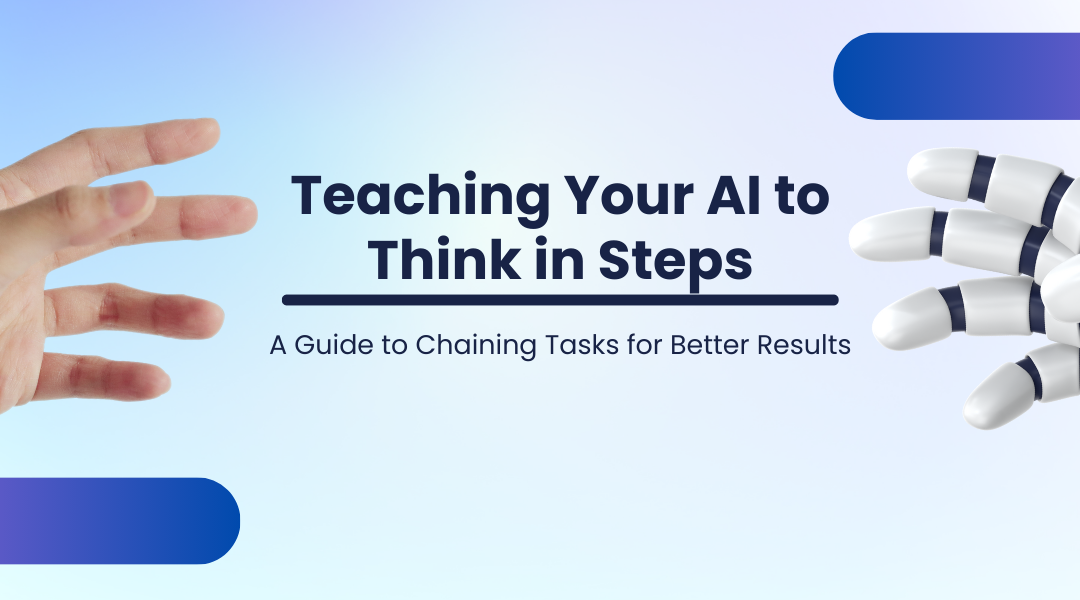We’ve all been there. You ask an AI a broad, complex question and get back a generic, surface-level answer that misses the mark. The problem often isn’t the AI’s capability—it’s the instruction manual we provided. The real magic happens when we stop treating the AI like a search engine and start treating it like an apprentice, guiding its thought process one logical step at a time.
This approach, often called task-chaining or sequential prompting, is about breaking down a monumental task into a series of smaller, manageable instructions. It’s the difference between yelling “Build a house!” and providing an architect’s blueprint, followed by specific orders to first lay the foundation, then frame the walls, and finally install the roof. The latter method yields a coherent, sturdy structure. The former gets you a pile of lumber.
Why Bother with Steps? The Power of a Guided Workflow
Asking an AI to perform a complex task in one go is like asking someone to solve a complicated math problem in their head—it’s prone to errors, oversimplification, and missed details. A sequential approach works better because it:
- Prevents Overwhelm: It focuses the AI’s vast knowledge on one specific job at a time, dramatically increasing accuracy and relevance.
- Maintains Context: Each step builds on the output of the previous one, creating a thread of logic that runs through the entire response. The AI isn’t just answering; it’s building a narrative or an argument.
- Allows for Course Correction: By designing the sequence, you can spot where the logic might break down and add specific instructions at just the right point to keep everything on track.
How to Build Your Chain: A Practical Framework
Crafting an effective chain of prompts is less about technical jargon and more about clear project management. Here’s how to think about it:
- Start with the End Goal: Work backwards. What is the final, perfect output you want to see? A comprehensive report? A creative story? A analyzed dataset? Define this first.
- Map the Mental Milestones: What are the natural phases of completing this task? A writer doesn’t just start typing a novel; they research, brainstorm, outline, draft, and edit. Your AI should follow a similar path.
- Write Clear, Atomic Instructions: Each prompt in your chain should have one single, clear objective. Avoid combining two tasks into one prompt. The output of one step should be the perfect input for the next.
- Provide Contextual Hand-offs: Don’t assume the AI will remember everything. Use phrases like “Based on the outline you just created…” or “Now, using the three key points you identified…” to explicitly connect the steps.
Putting It Into Practice: From a Messy Question to a Clear Process
Let’s move from theory to practice. Imagine you want to create a marketing plan for a new product.
The Single, Overwhelming Prompt (The Old Way):
“Write a marketing plan for a new eco-friendly coffee mug.”
The Sequential, Guided Approach (The New Way):
- Step 1 (Research & Brainstorming):
“Act as a market analyst. List the top 5 target customer segments for a new premium, eco-friendly coffee mug. For each segment, describe their primary motivation for buying such a product and one key marketing channel to reach them.” - Step 2 (Synthesis & Strategy):
“Based on that list, choose the most promising target segment for an initial launch. Now, draft a core marketing message that would specifically appeal to that segment’s motivations. The message should be one sentence long.” - Step 3 (Execution & Creation):
“Using the marketing message you just crafted, write a short, engaging Facebook ad (under 150 characters) and suggest a compelling image concept for the ad.” - Step 4 (Analysis):
“Finally, what is one potential obstacle to selling to this segment, and what is a strategy to overcome it?”
Notice: how each prompt is a self-contained task, yet they logically build upon each other. The AI isn’t guessing; it’s executing a pre-defined strategy.
Conclusion: From Commander to Conductor
Mastering multi-step prompts is a paradigm shift in how we interact with AI. We transition from being a commander who barks orders to a conductor who orchestrates a symphony of intelligence. You are not replaced by the AI; your role is elevated. You become the strategist, the editor, and the quality control, guiding the raw computational power to a refined and purposeful conclusion.
This method requires more upfront thought than a single query, but the payoff is immense: outputs that are deeper, more accurate, and uniquely tailored to your specific needs. It’s the key to unlocking truly professional, reliable, and sophisticated work from AI, transforming it from a simple tool into a collaborative partner. By teaching it to think in steps, you teach it to think like you.
